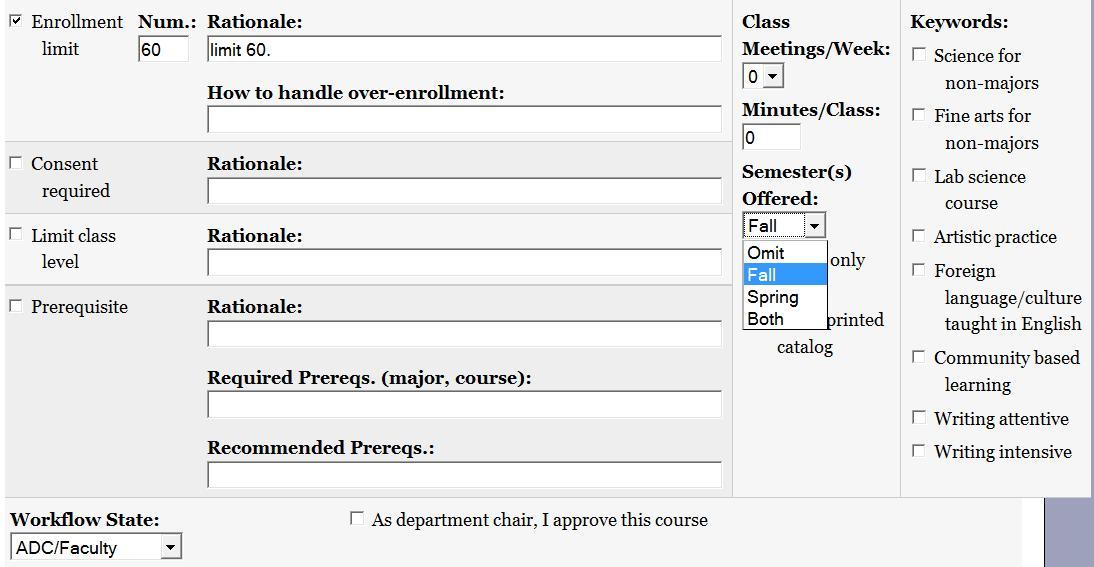Course title and numbers | Course description | Metadata | Writing attentive, Writing intensive | Course catalog workflow
When you click Edit next to an existing course, you get a course editing screen pre-populated with the existing data about the course. When you add a new course, you get a blank course editing screen.
It is important that the department coordinator check the information about every existing course so that the information reflects the status of the course for the upcoming academic year. For example, if a course was omitted in 0910 but will be offered in 1011, the ADC should update the description to reflect that fact.
Titles and Numbers
The top part of the course editor contains number and title information, as well as the Datatel Course ID of the course and information about existing cross-listings. Don't touch the Datatel ID; the Registrar handles this. Also, you can only view Cross-listings here; you create and delete them elsewhere.
The section number can normally be left blank. It is necessary only in those limited instances (such English 01) where the course sections have completely different titles and descriptions.

Description
The middle part of the editor contains instructor information and the course description. Enter the instructor's last name (or first initial, last name, where the last name is not unique. The Semester(s) drop down indicates when that particular instructor will teach the course. Where a course is co-taught, the second instructor will have the same Semester(s) setting as the first. Where a course is taught by different people in the Fall and Spring, use the Semester(s) drop down to indicate who teaches when.

Metadata

Writing attentive:Any course in any discipline can define itself as Writing Attentive (W) if it has as one of its conscious and stated objectives the improvement of students’ critical writing, whether that writing is highly discipline-specific (e.g., a lab report) or broader in its application. Whether a course counts as a W course is determined not so much by the number of pages of writing students produce as by the uses to which that writing is put. In particular, writing assignments should be used at least in part for the purpose of improving students’ writing skills rather than solely as evidence of their mastery of course content. Accordingly, in W courses, students can reasonably expect to receive extensive feedback not only on the content but also on the form of their writing. This feedback might be given in a variety of ways, e.g., written comments, one-on-one paper conferences, and/or classroom discussion of samples of student writing.Writing intensive:Designed specifically to meet the needs of students whose secondary education did not adequately prepare them for writing at Amherst College. Students who take these courses will be taught the fundamentals of academic writing: thesis development, the use and citation of secondary sources, cogent argumentation, effective organization, the construction of coherent and unified paragraphs, and the crafting of complex yet clear sentences whose grammatical structure accurately mirrors the logical relations between the ideas they express. Though a significant amount of class time will be devoted to writing instruction, these courses are based squarely within a particular discipline and may count toward the major in the department in which they are taught.
Workflow
The last two items in the course editor--aside for the Save and Delete buttons--are the Workflow State and a checkbox for the department chair. While a course is under the purview of the department it can be one of three states: Proposal, ADC/Faculty, or Dept. Chair.
Only new courses should be in the Proposal state, where the members of the department can examine and amend the course. Once is appears likely that the department will go forward with the new course, it should be moved to the ADC/Faculty state. The difference between the two states is that a course in Proposal doesn't appear on reports generated for the Registrar and Dean, while courses in the ADC/Faculty state do.
Unlike new courses, existing courses always begin in the ADC/Faculty state, where the department coordinators and department members can view and edit them. Only when a course's information has been updated for the next academic year should it be moved to the Dept. Chair state.
What happens after a course is moved to the Dept. Chair state depends upon the its Status for This Year. If its status is No Change or Minor Revision then, after a couple of hours, the course will automatically move to the Publications state and will no longer be editable by member of the department. Note that the department chair does not have to approve such courses.
If a course's status is New or Major Revision, then it stays in the Dept. Chair state until the chair clicks the box that reads "As department chair, I approve this course." A couple of hours later, the course moves automatically to the Committees state, where members of the Dean's office shepherd it through the approval process. A course in Committees can no longer be edited by department members.
At the bottom of the screen, the Save button commits any changes you've made to the course.